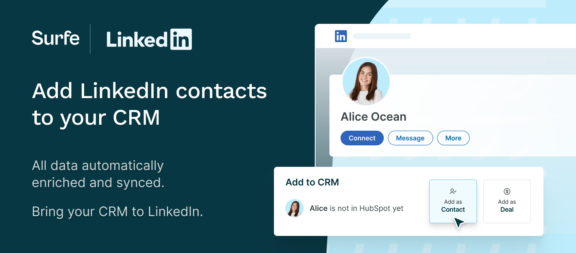Sales and Customer Service: The Duo Nobody Told You About

Question: What’s the difference between a good salesperson and a great salesperson?
(Don’t worry, we’re not telling a joke – you can keep reading).
Answer: How they work with their Customer Service team.
We know we bang on about the relationship between Sales and Marketing all the time, but that’s not the only connection you should be nurturing. Good job you like people, isn’t it 😉
Sales and Customer Service also need to work incredibly closely together if they want to see success. You might think of revenue as Sales’s responsibility and retention as Customer Service’s – but that approach is a little too simplistic for our liking.
Instead you need to think of revenue as the responsibility of sales and customer service, and retention as, you guessed it, also the responsibility of both teams.
Sitting there, scratching your head and thinking maybe you need to give your Customer Service team a bit of love? No, we can’t see into your office – but we can talk you through exactly why this is important and how you can make it happen. In this blog post, we’re going to discuss the unique responsibilities of and areas for collaboration between sales and customer service – and most importantly, how you can work together to increase revenue generation.
Even if you’re already besties with your Customer Service team, we promise you’ll still come away with some handy takeaways to implement today.
In a rush? Skip ahead:
- Understanding the Sales and Customer Service Roles
- The Importance of Collaboration
- Strategies for Effective Collaboration
- Utilizing the Right Tools for Collaboration
Without further ado – let’s get going.
Understanding Sales and Customer Service Roles
First things first, let’s take a look at exactly what Sales and Customer Service do:
Sales Team Responsibilities
We’re sure you’re familiar with this one, but just in case it’s your first EVER day of work – here’s what Sales are responsible for.
- Generating new revenue: in other words, selling to businesses that haven’t bought from your company before – and making your business money as a result.
- Prospecting and converting leads: to do this, you’re going to need to undertake some prospecting (finding these new businesses, usually by prospecting on LinkedIn) and converting (moving these businesses down the sales funnel to a close).
- Initiating upselling strategies: as it’s your responsibility to maximize new revenue, you need to keep an eye out for opportunities to upsell (encouraging a prospect to buy a more expensive version of your product than they were initially interested in). More on these in a minute.
Customer Service Team Responsibilities
A quick note before we get into the wonderful world of Customer Service: what this team is called varies from business to business. You might know them as the Customer Success team, or maybe something completely different.
Now we’ve got that out of the way, the Customer Service team is responsible for:
- Retaining existing customers: in a nutshell, this means making sure the customer gets an experience they can’t get anywhere else. If they don’t, what’s stopping them from moving elsewhere?
- Providing support and solving customer issues: this often involves working cross-functionally to help the customer. For example, Customer Service might ask Marketing to help with a customer’s press release, or they might need Engineering to solve a technical issue – ASAP.
- Implementing cross-selling strategies: we’re going to dive into these shortly – but essentially, it means encouraging the business to buy more from you. Once they’re happy with the initial service, of course.
Now we’ve got the roles and responsibilities of both teams out of the way, it’s time to make things a little more complicated. Don’t worry – just a tiny bit.
Essentially, there’s a cross-over between these responsibilities. Sales and Customer Service need to collaborate on all of the above to move the needle. Customer Service’s main responsibility may be retaining customers, but they also generate revenue through cross-selling. And the Sales team’s main responsibility may be generating revenue, but they also help retain customers by creating an excellent impression from the get-go -so the customer knows they can expect a solid relationship with the business and understands the value they’re going to get day-to-day.
The Relationship Between Sales and Customer Service: An Example
Want to see it in action? We’ve got you:
Meet Ben. Ben is not a great salesperson. He’s falling behind on his monthly target, so over exaggerates the benefits of his product to his next prospect. He’s pretty pushy, and it’s almost – but not quite – enough to make the prospect drop out of the sale.
They sign, and Ben is thrilled. He’s generated revenue – and hit his target. He pushes the prospect to the back of his mind. Job done.
The prospect, however, has the sneaking suspicion that they’ve been played. They’re instantly on edge when it comes to dealing with the Customer Service team, and, surprise surprise, are downright annoyed when it turns out that the product can’t actually do what Ben claimed it could do.
The Customer Service rep tries their best, but they’re in no position to generate revenue by upselling – the relationship’s just not good enough. Even worse, the customer churns after just three months. The business has lost potential upsell revenue and wasted money on acquiring the customer. Plus, it’s now having to do some serious reputation management.
That’s bad for the bottom line – and bad for Ben too, who loses his commission.
See what we mean?
The Importance of Collaboration between Sales and Customer Service
So, we’re (hopefully) clear now on why it’s important to collaborate when it comes to the customer experience. The more closely you work together, the better it will be, and the more likely it is that the customer will stay. And the longer the customer stays, the more opportunities there are to increase revenue – and the more everybody hits target.
One other thing to keep in mind: it’s more expensive to acquire a new business than it is to retain and upsell a business. That makes retention and upselling even more important for your bottom line.
Strategies for Effective Collaboration
Let’s move on to the good stuff: how to put the relationship between Sales and Customer Service into action. We recommend that sales focus on upselling and Customer Service focus on cross-selling – which in the long run means that Sales will be helping to retain users and Customer Service will be helping to generate revenue. Let’s jump in:
Sales-Driven Upselling
Sales-driven upselling encourages customers to purchase a more expensive version of the product they’re looking to buy. For example, if a customer comes to you wanting to purchase your Basic or Starter plan, you might recommend they actually purchase the next package up – which has better features and higher limits.
If you increase the overall value of the sale, you can consider your upselling job done.
Benefits of upselling include:
- Boosted revenue and profit margins: we’ll start with the easy one. If you manage to make a business spend more money, you’re going to see increased revenue and profit margins.
- Improved customer satisfaction: if a customer feels they’ve been sold the best solution for their unique business, they’re going to be happier. Simple!
- Demonstrated product range: by showing just how expansive your product offering is, you’re reinforcing your prospect’s perception of your business’s value. Plus, it opens the door to cross-selling later…
Introducing upselling opportunities may seem a little intimidating, but it doesn’t have to be. When it comes down to it, it’s really all about listening to your customers. You want to try really, really hard to understand their needs and their budget, alongside making a judgment on their level of interest. If you’re getting positive signs all round, then it’s time to give it a go.
Examples of effective upselling include:
- Offering a premium version or additional services, like we mentioned above
- Bundling together products or services for a reduced price – say, 10% off
- Building a personalized offer. For example, creating a more expensive package that’s totally unique to the prospects’ needs.
Customer Service-Driven Cross-Selling
Cross-selling is similar to upselling, but happens at a different stage of the relationship. It involves offering additional, complementary products related to their original purchase. The aim of the game here (apart from generating revenue) is to increase value for your customer by introducing them to products they might need or enjoy.
Identifying cross-selling opportunities basically comes down to the same thing as upselling: focusing on the needs of the customer. That means thinking long and hard about what’s going to genuinely help them, and being transparent about what purchasing an additional product means.
Examples of good cross-selling include:
- Personalizing your offer by showing the prospect how this new product speaks to their specific needs
- Offering discounted add-ons so your most loyal customers get the best deals
- Giving examples of products that other customers have purchased together, and explaining why the combination is beneficial
Maintaining a Unified Customer Journey
The key to creating a smooth, revenue-generating relationship between sales and customer service is the transition of the customer. Remember Ben, our hopeless salesperson from earlier? Don’t do what he did and wash your hands of the customer as soon as you’ve made the sale.
Instead, focus on maintaining consistent communication and data sharing. This makes sure that your Customer Service team has absolutely everything they need to kick off their relationship smoothly – things like KPIs, who influenced the sale and anything they need to keep in mind going forward.
On the customer side of things, you want to let them know exactly when the handoff is going to happen and what they can expect. It’s tempting to check in and make sure everything’s going ok – particularly if you and the customer have been through a long, arduous journey to a sale together – but it’s important to maintain boundaries and not muddy the waters. You don’t want the prospect reaching out to you when they experience a technical problem later down the line, as that’s going to make Customer Service’s job much, much harder.
Utilizing the Right Tools for Collaboration between Sales and Customer Service
The great thing about the relationship between Sales and Customer Service is that there are plenty of tips and tricks you can utilize to make things easier.
Our favorite tip? Use the same CRM. If you’re dealing with the same customer, you need to have access to exactly the same information – otherwise you’ll run into serious problems sooner rather than later. Using the same CRM keeps teams aligned on deals, contacts and relationships, so everything runs smoothly and efficiently right from the first point of contact.
Your CRM integrations have a role to play here, too. Let’s take an example: Surfe (hey 🙋).
Surfe is a handy tool that helps with prospecting (finding new leads for both teams to sell to). Essentially, users can find contact data for people they’d like to get in touch with, and then sync this data over to the CRM with just one click. It’s super beneficial for both Sales and Customer Service teams to use:
- Sales: Surfe streamlines the prospecting process by making it super quick and easy to find contact data and pass it over to the CRM. Once you’ve found the contact data you need, you can use it to reach out to your new prospect – building a connection and, later down the line, making a sale. Surfe’s LinkedIn templates also help here – users can iterate on their outreach process to find the messaging that works best for them.
- Customer Service: by enriching your CRM data, Surfe makes life far, far easier for the Customer Service team once the account’s been passed over to them. They’ll save valuable time searching for the contact data they need or filling in an incomplete CRM profile, as everything will already be in there. They can also review messages sent within LinkedIn, to make sure they know everything they need to about pain points and what the prospect’s expecting from the relationship.

Let’s Wrap It Up!
When Sales and Customer Service teams work together, beautiful things can happen. Generating revenue becomes easier, and customers stick around without any persuading. Bonuses abound and business’s bottom lines improve. And most importantly of all, both teams know they can rely on the other.
Just don’t let Marketing get jealous.

Start getting closer to Customer Service today
Want to make your colleague’s day? How does presenting them with a perfectly enriched CRM sound?
Download Surfe, and make it happen.
(btw – it’s free).
FAQs About Sales and Customer Service
What is the Relationship Between Sales and Customer Service?
Sales and Customer Service are two parts of the same function: growth. Broadly speaking, they’re responsible for generating revenue and making sure that customers stick around – which they do by working to build an excellent customer relationship from the get-go, and making sure the transfer over from Sales to Customer Service is as smooth as possible.
What Are the Skills Needed for Sales and Customer Service?
Sales and Customer Service need to have many overlapping skills, such as:
- Listening: both roles require good listening skills. It’s vital to be able to understand the pain points of the customer, and also to identify opportunities for upselling or cross-selling.
- Problem-solving: whether it’s working out what solution best suits the customer, or navigating the trickier parts of a long-term relationship, both roles need to be quick on their feet and adept at problem-solving.
- Relationship-building: both roles require building close relationships with the people they work with – both internally and externally. The more a prospect likes someone on a personal level, the more obligated they are to buy – and later down the line, buy more – from their business.
Is Customer Service Part of the Sales Team?
No, the Customer Service team is not part of the Sales Team – but they do live under the same umbrella: the revenue-generating function of your business. It’s important that both teams are in close communication at all times to make sure that maximum value is being pulled out of each customer.


